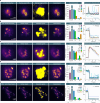Highly adaptable deep-learning platform for automated detection and analysis of vesicle exocytosis
- PMID: 40651941
- PMCID: PMC12255801
- DOI: 10.1038/s41467-025-61579-3
Highly adaptable deep-learning platform for automated detection and analysis of vesicle exocytosis
Abstract
Activity recognition in live-cell imaging is labor-intensive and requires significant human effort. Existing automated analysis tools are largely limited in versatility. We present the Intelligent Vesicle Exocytosis Analysis (IVEA) platform, an ImageJ plugin for automated, reliable analysis of fluorescence-labeled vesicle fusion events and other burst-like activity. IVEA includes three specialized modules for detecting: (1) synaptic transmission in neurons, (2) single-vesicle exocytosis in any cell type, and (3) nano-sensor-detected exocytosis. Each module uses distinct techniques, including deep learning, allowing the detection of rare events often missed by humans at a speed estimated to be approximately 60 times faster than manual analysis. IVEA's versatility can be expanded by refining or training new models via an integrated interface. With its impressive speed and remarkable accuracy, IVEA represents a seminal advancement in exocytosis image analysis and other burst-like fluorescence fluctuations applicable to a wide range of microscope types and fluorescent dyes.
© 2025. The Author(s).
Conflict of interest statement
Competing interests: The authors declare no competing interests.
Figures





References
-
- Slavík, J. Fluorescent probes. In: Fluorescence Microscopy and Fluorescent Probes (ed Slavík J.) (Springer US, 1996).
-
- Shroff, H., Testa, I., Jug, F. & Manley, S. Live-cell imaging powered by computation. Nat. Rev. Mol. Cell Biol.25, 443–463 (2024). - PubMed
-
- Becherer, U. et al. Regulated exocytosis in chromaffin cells and cytotoxic T lymphocytes: how similar are they? Cell Calcium52, 303–312 (2012). - PubMed
MeSH terms
Substances
Grants and funding
LinkOut - more resources
Full Text Sources

